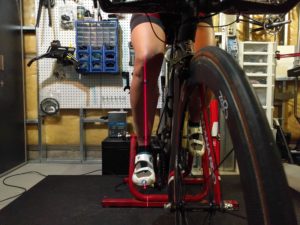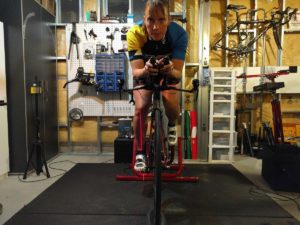

A dynamic bike fit is the process of discovering the optimal balance of comfort, power and aerodynamics while in functional motion, and confirming optimal ranges in this state. A dynamic fit bike allows the fitter to make adjustments instantaneously while in motion without the confines of mechanical stops due to equipment changes in between testing different bike fit configurations for comfort and power. This results in immediate feedback and confirmation from the customer for minute refinements.
Digital capture using modern devices reads angles of the body while in motion to confirm the F.I.S.T optimal ranges. Optional pedal and cleat assessment and fitting to further distribute power across the foot more evenly, alleviate hot-spotting/numbness and correct leg travel is available. In home dynamic bike fitting also available.
Key Benefits:
Fitter can change easily change bars, pedals, crank length, saddle (height and width), saddle type. Less time spent working on equipment, more time spent focusing on fitting.
Fitter can make instantaneous changes for quick feedback during the fitting process for accurate comparisons between trials.
Allows for saddle and handlebar/pad x/y changes while continuously riding.
Accurate frame sizing before an investment in multiple thousands of dollars, saving the chance of a bike not fitting/handling correctly.
Changes to existing bike can be completed much quicker from coordinate outputs.
What a Dynamic Fit Entails
A physical assessment is performed focusing on flexibility, strengths, weaknesses, past and present injuries and any pains/discomforts the athlete had on the bike in the past as well as currently.
A goal assessment of what the athlete’s plans are for 1 year, 2 year, 5 year goals are and discussion of how the results of today will play into these goals.
A historical assessment of prior achievements, competitiveness and level of fitness.
An equipment assessment of the athlete’s current bike and any possible changes/incorporations that would be accommodated for in the fit.
An initial position based off your estimated saddle height is entered in the bike and from there further adjustments called trials are made as we approach optimal comfort and body angle ranges. Each trial is captured on video and digital angle measuring devices capture the body angles associated with each trial.
After all adjustments have been made a capture is made of the final trial and the fit sheet is finalized.
A list of bikes that fit the new found coordinates will be made generated by the stack and reach numbers attained from the best fitting trial.
If utilizing an existing bike, there is an option to adapt this bike to the resulting fit output. If unable to achieve this fit on this bike, either a new bike from the list can be pursued or the existing bike can be adjusted to a previous trial closest to the final trial and when ready, can use the list to purchase a new bike.
Results of a Dynamic Fit:
Our goals for the customer is to walk away with the following:
A fit that is comfortable so it is maintainable while maximizing power output and improving aerodynamics.
A prescribed list of bikes that are optimally sized to the final trial with the correct stem size or pad x/y coordinates focusing on adaptability and will handle well underneath the athlete.
Photos of each trial through to the final selected trial.
A bike fit report document that can be brought to any bicycle shop for a new purchase, an existing adjustment or reassembly.
BIKEFIT Pedal and Cleat Fitting
The foot-pedal interface is one of the most important connections to the bicycle. Cycling shoes have not evolved to adapt to individual foot styles as running shoes have. The ground contact of running greatly differs from cycling where it can be more related to having a plank strapped to your foot. A misalignment of the cleat will send a chain reaction of imbalance between the foot, to another almost fixed contact point, the saddle. Small changes can balance pressure on the ball of the foot, lessen or eliminate hot spotting/numbing… or do the opposite.
Key Benefits:
Improved knee tracking
Improved pressure balance at the ball of the foot
Reduction in hot spotting/numbing
Better alignment during power phase of pedal stroke
Achieve the best foot position to create the maximal biomechanical efficiency in the lower extremity and reduce the risk of injury
What a Pedal and Cleat Fitting Entails:
A physical assessment is performed focusing on strengths, weaknesses, past and present injuries and any pains/discomforts the athlete had on the bike in the past as well as currently.
An equipment assessment of the athlete’s current bike and any possible changes/incorporations that would be accommodated for in the fit.
Initial review of existing cleat position and cleat wear and correlation to the physical assessment incluing manual or digital measurement of foot tilt.
Initial observation and recording of existing cleat position while cycling using laser alignment tool.
Adjustments fore/aft/medial/lateral/tilt/float to improve biomechanical efficiency and improve pressure dispersion.
Final observation and recording of finalized cleat position while cycling using laser alignment tool.
Results of a Pedal and Cleat Fitting:
Our goals for the customer is to walk away with the following:
A better lower extremity biomechanical motion to reduce injury.
A better distribution of pressure under the ball of the foot to help alleviate hot spotting/numbness.
Digital comparisons of before and after pedal and/or cleat adjustment.